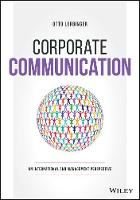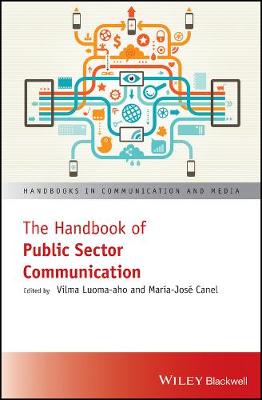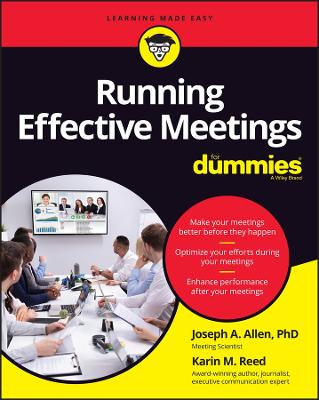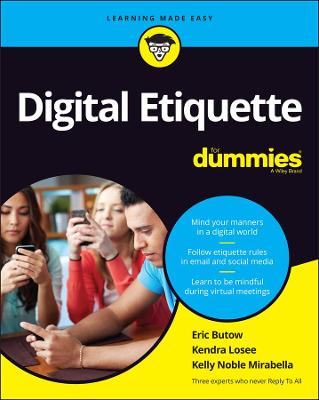Corporate Communication
 -15%
portes grátis
-15%
portes grátis
Corporate Communication
An International and Management Perspective
Lerbinger, Otto
John Wiley and Sons Ltd
12/2018
360
Mole
Inglês
9781119471370
15 a 20 dias
576
Descrição não disponível.
Preface xiii
Acknowledgements xv
Author Biography xvii
Overview of the Book's Five Parts xix
Part I The Extended Enterprise 1
1 Introduction: The Domain of Corporate Communication 5
1.1 Stakeholder Management 6
1.2 Twin Goals of Corporate Communication 7
1.2.1 Strengthening Relationships with Stakeholders 7
1.2.2 Maintaining Corporate Reputation 9
1.3 Conclusions 11
Discussion Questions 12
2 Stakeholder Relations: Investors and Employees 15
2.1 Investor Relations 15
2.1.1 SEC's Full and Timely Disclosure Rules 16
2.1.2 Feedback and Power 16
2.1.3 Investor Relations Activities 17
2.2 Employee Relations 18
2.2.1 Maslow's Hierarchy of Needs 18
2.2.2 Employee Communications 19
2.2.3 Recruitment and Training of Workers 20
2.2.4 Helping Workers Adjust to Foreign Employers 22
2.2.5 Labor Unions and Collective Bargaining 22
2.2.6 Standardization vs. Customization of Employee Relations 24
2.3 Conclusions 24
Discussion Questions 25
3 Stakeholder Relations: The Community and Consumers 28
3.1 Community Relations 28
3.1.1 Programs and Activities 29
3.1.2 Importance in Oil and Mining Industries 30
3.1.3 Developing a Community Relations Program 31
3.2 Consumer Relationship Management (CRM) 31
3.2.1 Moving from a Transaction to a Relationship 32
3.2.2 Social Contract and Consumer Rights 33
3.2.3 Power Relationship 34
3.2.4 Social Responsibility to Consumers and Society 34
3.2.5 Emerging Concept of "Social CRM" 36
3.2.6 Privacy 37
3.3 Conclusions 38
Discussion Questions 38
Case 1 General Electric - Profile of a Multi-National Corporation 40
Case 2 Wells Fargo Misapplies CRM 44
Part II Strategic Application of Communication Practices 51
4 Public Relations: Influencing Public Opinion 55
4.1 Historical Connection Between Public Relations and Public Opinion 56
4.1.1 The Public Relations Audit 56
4.1.2 Use of Surveys in Public Relations 57
4.1.3 Current Difficulties with Surveys 58
4.1.4 The Edelman Trust Barometer 59
4.1.5 CNBC/Burson-Marsteller Corporate Perception Indicator 59
4.1.6 Pew Research and Just Capital 60
4.2 Gaining Influence Through Publicity 60
4.2.1 Applying Perception Management: Putting "a Spin" on a Story 61
4.2.2 The Challenge Faced by Publicity: Limited Human "Channel Capacity" 62
4.2.3 Proactive Media Relations Strategy 62
4.2.4 Bernays - A Prominent Publicist 62
4.2.5 Harold Burson - Thoughts About Public Opinion 63
4.2.6 Proactive Media Relations 63
4.3 International Application of Persuasion 64
4.3.1 Public Diplomacy Campaigns 65
4.3.2 Business Support 65
4.3.3 Social Media Support 66
4.4 International Differences and Constraints in Media Relations 66
4.4.1 Use of "Guanxi" and Press Clubs 67
4.4.2 Unprofessional Practices 67
4.4.3 Constraints on Press Freedom 68
4.4.4 Singapore's Authoritarianism 69
4.4.5 Insult Laws 69
4.4.6 Concentrated Media Ownership 69
4.5 Conclusions 70
Discussion Questions 70
4.A Foreign Media Relations Guide 71
5 Public Affairs: Exercising Power in the Socio-Political Environment 76
5.1 Central Role of Government Relations 77
5.1.1 Government Relations in China 77
5.1.2 Cases of Intervention by Governments 77
5.2 Government Litigation 81
5.3 The Term "Corporate Diplomacy" Grows 82
5.4 Tools of Public Affairs 83
5.4.1 Negotiations 83
5.4.2 Lobbying 84
5.5 Conclusions 86
Discussion Questions 86
6 Global Marketing Communication: Facilitating Exchanges 91
6.1 Integrated Marketing Communication (IMC) 91
6.2 The Marketing Mix: The 4 Ps 92
6.2.1 Product, Price, and Place 93
6.2.2 The Promotion Mix 95
6.3 Accommodating International Differences 98
6.3.1 "Think Global, Act Local" - Global Brand Architecture 98
6.3.2 Standardization vs Customization 99
6.3.3 Recognizing Cultural Differences 100
6.4 Conclusions 101
Discussion Questions 102
7 Social Media and Big Data: Extending Relationships 106
7.1 The Internet 106
7.1.1 Overseas Expansion Invites Languages Other than English 107
7.2 Social Media Marketing 108
7.2.1 Major Types 108
7.2.2 Videos - Additional Impact 110
7.2.3 Viral and Buzz Marketing 110
7.3 Social Media Impact on Corporate Communications 112
7.3.1 Changed Power Relations 112
7.4 Big Data - its Uses and Limitations 113
7.4.1 Analyzing Big Data 113
7.4.2 Applications of Big Data Analysis 114
7.5 Improving the Reliability of Big Data 117
7.5.1 Limitations of Big Data 117
7.5.2 New Approaches and Research Centers 118
7.6 The Future of Big Data - The Next Step 119
7.6.1 Artificial Intelligence (AI) 119
7.7 Conclusions 119
Discussion Questions 120
8 Digital and Social Marketing: Extending Practices and Influencing Behavior 124
8.1 Growth of Digital Marketing 124
8.1.1 Awareness of New Technology by Public Relations and Public Affairs 124
8.1.2 New University Degree Programs and Company Positions 125
8.1.3 Impact of Digital Marketing 126
8.1.4 Role of Public Affairs and Advocacy Advertising 126
8.2 Social Marketing - Changing Consumer and Citizen Attitudes and Behavior 127
8.2.1 Application to Public Health 128
8.2.2 Tackling the Obesity Issue Worldwide 128
8.2.3 Use of Wide Range of Communication Practices 131
8.3 Conclusions 131
Discussion Questions 131
Case 3 High Drug Prices Become a Public Issue 133
Case 4 Uber Requires Public Affairs Assistance and Cultural Overhaul 139
Part III International Perspective 147
9 The Force of Globalization 151
9.1 Conditions That Facilitate Globalization 152
9.1.1 Enabling Effect of Communication and Other Technologies 152
9.1.2 Rise of Scientific Thinking 153
9.2 Drivers of Globalization 153
9.2.1 Search for New Markets 154
9.2.2 Seeking Low Labor Costs 154
9.2.3 Seeking National and Company Growth 156
9.2.4 The Newest Driver: Inversion Deals 157
9.3 Obstacles to Globalization 158
9.3.1 Resurgent Nationalism 159
9.3.2 National Security Concerns 160
9.3.3 Weak Infrastructures 162
9.3.4 Widening Income Disparities 163
9.4 Saving Globalization 164
9.5 Conclusions 165
Discussion Questions 166
10 Interacting with International Players 171
10.1 Powerful MNCs 171
10.1.1 Illustrative Company Profiles 172
10.2 Nation States 173
10.2.1 China's Antitrust and Bribery Actions 173
10.2.2 France Confronts Google Over Its Tax Deal 174
10.3 Supranational Organizations 174
10.3.1 United Nations 175
10.3.2 World Economic Institutions 177
10.4 European Union 177
10.5 Civil Society 181
10.6 NGOs as Advocacy Groups 182
10.7 Collaboration is Growing 183
10.8 Conclusions 184
Discussion Questions 184
11 Political and Economic Features of Nation States 188
11.1 Major Political Systems and Ideologies 188
11.1.1 Authoritarian Systems 188
11.1.2 Democratic Systems 190
11.2 Major Economic Systems 190
11.2.1 Free Market System 190
11.2.2 Command and Control Economies 192
11.2.3 Mixed Systems: Social Corporativism and Social Capitalism 193
11.3 Political Risk Assessment 193
11.3.1 Due Diligence in AES's Acquisition of Telsi in the Republic of Georgia 194
11.4 Conclusions 195
Discussion Questions 195
12 Social and Cultural Features of Nation States 198
12.1 Major Aspects of a Country's Social System 199
12.1.1 Community Institutions 199
12.1.2 Demographics and Other Forms of Audience Segmentation 202
12.2 Features of Cultural Systems 203
12.2.1 Individualism vs. Collectivism 204
12.2.2 Power Distance 205
12.2.3 Uncertainty Avoidance 206
12.2.4 Masculinity-Femininity 207
12.2.5 High vs. Low Context 207
12.2.6 Other Cultural Variables 208
12.3 Media Systems 209
12.3.1 Al Jazeera 209
12.4 Conclusions 209
Discussion Questions 209
13 The Nation Brand: Comparison with Product and Company Brand 213
13.1 Differences between Brand and Reputation 214
13.1.1 Anholt-GfK Roper Nation Brands Index 214
13.2 Building and Strengthening a Nation State 215
13.2.1 Nation-Building 215
13.2.2 Economic Development 216
13.2.3 Attracting Industry: Approaches by Countries and Cities 217
13.3 Strategy to Attract Foreign Investment 219
13.4 How Nation Brands Are Tarnished 220
13.4.1 Reputational Risks and Crises 220
13.5 Strengthening a Nation Brand 221
13.5.1 Olympics 222
13.6 World Economic Forum 222
13.7 Conclusions 223
Discussion Questions 223
Case 5 Can Public Relations Promote Globalization? 225
Case 6 Building China's Nation Brand 227
Part IV Pivotal Issues Facing Management 235
14 Sustainability and Climate Change 237
14.1 Sustainability Begins with the Environment 237
14.1.1 Social Costs and Social Reports 238
14.1.2 Environmental Programs 238
14.2 Focus on Availability of Natural Resources 239
14.2.1 The Price System and Recycling 240
14.2.2 Greater Attention to Supplier Relations 240
14.2.3 Unilever Launches a Broad-Scale Plan 243
14.2.4 Other Sustainability Measures 243
14.3 Climate Change: The Ultimate Sustainability Challenge 245
14.3.1 Global Warming and Human Activity Argument 246
14.3.2 Application of Communication Practices 248
14.3.3 International Actions and Agreements 249
14.4 Conclusions 251
Discussion Questions 252
15 Technology and Innovation: New Risks and Issues 256
15.1 Gaining Acceptance for New Technologies 257
15.1.1 The Diffusion/Adoption Process 258
15.1.2 Controversial Technologies 258
15.2 Intellectual Property Rights 260
15.2.1 Patent Disputes and Theft of IP 260
15.2.2 Litigation Public Relations 261
15.3 Technology Creates Risks 262
15.4 The Science and Healthcare Settings of Technology 263
15.4.1 Science Settings at the Whitehead Institute and Brookhaven National Lab 263
15.4.2 Healthcare Settings 264
15.5 Conclusions 267
Discussion Questions 267
Appendix 268
Science Writing 268
Two Litigation Cases 268
Case 7 Reputational Crisis Faced by Samsung in Faulty Galaxy Note 7 Recall 270
Part V Corporate Communication Contribution to Management 277
16 Global Corporate Social Responsibility 281
16.1 Corporate Irresponsibility Abroad 281
16.1.1 Poor Working Conditions: The Bangladesh Disaster 281
16.1.2 Sales of Dangerous Products Abroad 282
16.1.3 Foreign Purchases of Agricultural Land 282
16.1.4 Offensive Banking and Insurance Practices 283
16.2 Foundations of Global Corporate Social Responsibility 283
16.2.1 A Common Code of Ethics and Professional Standards 283
16.2.2 Observing Global Declarations 284
16.3 Management Approaches to Corporate Social Responsibility 285
16.3.1 A Compensatory Approach to CSR: Social Bookkeeping 285
16.3.2 The Global CSR Pyramid 287
16.3.3 Corporate Citizenship 289
16.3.4 New Business Models 290
16.4 Forging International Agreements - the Case of Bangladesh 291
16.4.1 Nike Shows the Way 291
16.4.2 Some CSR Lessons Learned 292
16.5 Conclusions 293
Discussion Questions 293
17 Corporate Governance: The Corporate Communication Role 296
17.1 Maintaining Corporate Legitimacy 296
17.1.1 Uncertainty of Public Support for Business 297
17.1.2 Protecting the Free Market System 298
17.2 The Business-Society Relationship 298
17.2.1 Widening the Composition of the Board 299
17.2.2 Boards Face Activists 300
17.3 Shareholder Resolutions 301
17.4 Role of Corporate Communication in Corporate Governance 301
17.4.1 Protect Company Reputation and Legitimacy 301
17.4.2 Engage in Issues Management and Direct Crisis Management 303
17.4.3 Factor Public Opinion into Corporate Decision Making 304
17.4.4 Help Managers Engage with Stakeholders 305
17.4.5 Address the Public Interest 306
17.5 Conclusions 310
Discussion Questions 310
Case 8 VW's Crisis of Corporate Governance 312
Index 325
Acknowledgements xv
Author Biography xvii
Overview of the Book's Five Parts xix
Part I The Extended Enterprise 1
1 Introduction: The Domain of Corporate Communication 5
1.1 Stakeholder Management 6
1.2 Twin Goals of Corporate Communication 7
1.2.1 Strengthening Relationships with Stakeholders 7
1.2.2 Maintaining Corporate Reputation 9
1.3 Conclusions 11
Discussion Questions 12
2 Stakeholder Relations: Investors and Employees 15
2.1 Investor Relations 15
2.1.1 SEC's Full and Timely Disclosure Rules 16
2.1.2 Feedback and Power 16
2.1.3 Investor Relations Activities 17
2.2 Employee Relations 18
2.2.1 Maslow's Hierarchy of Needs 18
2.2.2 Employee Communications 19
2.2.3 Recruitment and Training of Workers 20
2.2.4 Helping Workers Adjust to Foreign Employers 22
2.2.5 Labor Unions and Collective Bargaining 22
2.2.6 Standardization vs. Customization of Employee Relations 24
2.3 Conclusions 24
Discussion Questions 25
3 Stakeholder Relations: The Community and Consumers 28
3.1 Community Relations 28
3.1.1 Programs and Activities 29
3.1.2 Importance in Oil and Mining Industries 30
3.1.3 Developing a Community Relations Program 31
3.2 Consumer Relationship Management (CRM) 31
3.2.1 Moving from a Transaction to a Relationship 32
3.2.2 Social Contract and Consumer Rights 33
3.2.3 Power Relationship 34
3.2.4 Social Responsibility to Consumers and Society 34
3.2.5 Emerging Concept of "Social CRM" 36
3.2.6 Privacy 37
3.3 Conclusions 38
Discussion Questions 38
Case 1 General Electric - Profile of a Multi-National Corporation 40
Case 2 Wells Fargo Misapplies CRM 44
Part II Strategic Application of Communication Practices 51
4 Public Relations: Influencing Public Opinion 55
4.1 Historical Connection Between Public Relations and Public Opinion 56
4.1.1 The Public Relations Audit 56
4.1.2 Use of Surveys in Public Relations 57
4.1.3 Current Difficulties with Surveys 58
4.1.4 The Edelman Trust Barometer 59
4.1.5 CNBC/Burson-Marsteller Corporate Perception Indicator 59
4.1.6 Pew Research and Just Capital 60
4.2 Gaining Influence Through Publicity 60
4.2.1 Applying Perception Management: Putting "a Spin" on a Story 61
4.2.2 The Challenge Faced by Publicity: Limited Human "Channel Capacity" 62
4.2.3 Proactive Media Relations Strategy 62
4.2.4 Bernays - A Prominent Publicist 62
4.2.5 Harold Burson - Thoughts About Public Opinion 63
4.2.6 Proactive Media Relations 63
4.3 International Application of Persuasion 64
4.3.1 Public Diplomacy Campaigns 65
4.3.2 Business Support 65
4.3.3 Social Media Support 66
4.4 International Differences and Constraints in Media Relations 66
4.4.1 Use of "Guanxi" and Press Clubs 67
4.4.2 Unprofessional Practices 67
4.4.3 Constraints on Press Freedom 68
4.4.4 Singapore's Authoritarianism 69
4.4.5 Insult Laws 69
4.4.6 Concentrated Media Ownership 69
4.5 Conclusions 70
Discussion Questions 70
4.A Foreign Media Relations Guide 71
5 Public Affairs: Exercising Power in the Socio-Political Environment 76
5.1 Central Role of Government Relations 77
5.1.1 Government Relations in China 77
5.1.2 Cases of Intervention by Governments 77
5.2 Government Litigation 81
5.3 The Term "Corporate Diplomacy" Grows 82
5.4 Tools of Public Affairs 83
5.4.1 Negotiations 83
5.4.2 Lobbying 84
5.5 Conclusions 86
Discussion Questions 86
6 Global Marketing Communication: Facilitating Exchanges 91
6.1 Integrated Marketing Communication (IMC) 91
6.2 The Marketing Mix: The 4 Ps 92
6.2.1 Product, Price, and Place 93
6.2.2 The Promotion Mix 95
6.3 Accommodating International Differences 98
6.3.1 "Think Global, Act Local" - Global Brand Architecture 98
6.3.2 Standardization vs Customization 99
6.3.3 Recognizing Cultural Differences 100
6.4 Conclusions 101
Discussion Questions 102
7 Social Media and Big Data: Extending Relationships 106
7.1 The Internet 106
7.1.1 Overseas Expansion Invites Languages Other than English 107
7.2 Social Media Marketing 108
7.2.1 Major Types 108
7.2.2 Videos - Additional Impact 110
7.2.3 Viral and Buzz Marketing 110
7.3 Social Media Impact on Corporate Communications 112
7.3.1 Changed Power Relations 112
7.4 Big Data - its Uses and Limitations 113
7.4.1 Analyzing Big Data 113
7.4.2 Applications of Big Data Analysis 114
7.5 Improving the Reliability of Big Data 117
7.5.1 Limitations of Big Data 117
7.5.2 New Approaches and Research Centers 118
7.6 The Future of Big Data - The Next Step 119
7.6.1 Artificial Intelligence (AI) 119
7.7 Conclusions 119
Discussion Questions 120
8 Digital and Social Marketing: Extending Practices and Influencing Behavior 124
8.1 Growth of Digital Marketing 124
8.1.1 Awareness of New Technology by Public Relations and Public Affairs 124
8.1.2 New University Degree Programs and Company Positions 125
8.1.3 Impact of Digital Marketing 126
8.1.4 Role of Public Affairs and Advocacy Advertising 126
8.2 Social Marketing - Changing Consumer and Citizen Attitudes and Behavior 127
8.2.1 Application to Public Health 128
8.2.2 Tackling the Obesity Issue Worldwide 128
8.2.3 Use of Wide Range of Communication Practices 131
8.3 Conclusions 131
Discussion Questions 131
Case 3 High Drug Prices Become a Public Issue 133
Case 4 Uber Requires Public Affairs Assistance and Cultural Overhaul 139
Part III International Perspective 147
9 The Force of Globalization 151
9.1 Conditions That Facilitate Globalization 152
9.1.1 Enabling Effect of Communication and Other Technologies 152
9.1.2 Rise of Scientific Thinking 153
9.2 Drivers of Globalization 153
9.2.1 Search for New Markets 154
9.2.2 Seeking Low Labor Costs 154
9.2.3 Seeking National and Company Growth 156
9.2.4 The Newest Driver: Inversion Deals 157
9.3 Obstacles to Globalization 158
9.3.1 Resurgent Nationalism 159
9.3.2 National Security Concerns 160
9.3.3 Weak Infrastructures 162
9.3.4 Widening Income Disparities 163
9.4 Saving Globalization 164
9.5 Conclusions 165
Discussion Questions 166
10 Interacting with International Players 171
10.1 Powerful MNCs 171
10.1.1 Illustrative Company Profiles 172
10.2 Nation States 173
10.2.1 China's Antitrust and Bribery Actions 173
10.2.2 France Confronts Google Over Its Tax Deal 174
10.3 Supranational Organizations 174
10.3.1 United Nations 175
10.3.2 World Economic Institutions 177
10.4 European Union 177
10.5 Civil Society 181
10.6 NGOs as Advocacy Groups 182
10.7 Collaboration is Growing 183
10.8 Conclusions 184
Discussion Questions 184
11 Political and Economic Features of Nation States 188
11.1 Major Political Systems and Ideologies 188
11.1.1 Authoritarian Systems 188
11.1.2 Democratic Systems 190
11.2 Major Economic Systems 190
11.2.1 Free Market System 190
11.2.2 Command and Control Economies 192
11.2.3 Mixed Systems: Social Corporativism and Social Capitalism 193
11.3 Political Risk Assessment 193
11.3.1 Due Diligence in AES's Acquisition of Telsi in the Republic of Georgia 194
11.4 Conclusions 195
Discussion Questions 195
12 Social and Cultural Features of Nation States 198
12.1 Major Aspects of a Country's Social System 199
12.1.1 Community Institutions 199
12.1.2 Demographics and Other Forms of Audience Segmentation 202
12.2 Features of Cultural Systems 203
12.2.1 Individualism vs. Collectivism 204
12.2.2 Power Distance 205
12.2.3 Uncertainty Avoidance 206
12.2.4 Masculinity-Femininity 207
12.2.5 High vs. Low Context 207
12.2.6 Other Cultural Variables 208
12.3 Media Systems 209
12.3.1 Al Jazeera 209
12.4 Conclusions 209
Discussion Questions 209
13 The Nation Brand: Comparison with Product and Company Brand 213
13.1 Differences between Brand and Reputation 214
13.1.1 Anholt-GfK Roper Nation Brands Index 214
13.2 Building and Strengthening a Nation State 215
13.2.1 Nation-Building 215
13.2.2 Economic Development 216
13.2.3 Attracting Industry: Approaches by Countries and Cities 217
13.3 Strategy to Attract Foreign Investment 219
13.4 How Nation Brands Are Tarnished 220
13.4.1 Reputational Risks and Crises 220
13.5 Strengthening a Nation Brand 221
13.5.1 Olympics 222
13.6 World Economic Forum 222
13.7 Conclusions 223
Discussion Questions 223
Case 5 Can Public Relations Promote Globalization? 225
Case 6 Building China's Nation Brand 227
Part IV Pivotal Issues Facing Management 235
14 Sustainability and Climate Change 237
14.1 Sustainability Begins with the Environment 237
14.1.1 Social Costs and Social Reports 238
14.1.2 Environmental Programs 238
14.2 Focus on Availability of Natural Resources 239
14.2.1 The Price System and Recycling 240
14.2.2 Greater Attention to Supplier Relations 240
14.2.3 Unilever Launches a Broad-Scale Plan 243
14.2.4 Other Sustainability Measures 243
14.3 Climate Change: The Ultimate Sustainability Challenge 245
14.3.1 Global Warming and Human Activity Argument 246
14.3.2 Application of Communication Practices 248
14.3.3 International Actions and Agreements 249
14.4 Conclusions 251
Discussion Questions 252
15 Technology and Innovation: New Risks and Issues 256
15.1 Gaining Acceptance for New Technologies 257
15.1.1 The Diffusion/Adoption Process 258
15.1.2 Controversial Technologies 258
15.2 Intellectual Property Rights 260
15.2.1 Patent Disputes and Theft of IP 260
15.2.2 Litigation Public Relations 261
15.3 Technology Creates Risks 262
15.4 The Science and Healthcare Settings of Technology 263
15.4.1 Science Settings at the Whitehead Institute and Brookhaven National Lab 263
15.4.2 Healthcare Settings 264
15.5 Conclusions 267
Discussion Questions 267
Appendix 268
Science Writing 268
Two Litigation Cases 268
Case 7 Reputational Crisis Faced by Samsung in Faulty Galaxy Note 7 Recall 270
Part V Corporate Communication Contribution to Management 277
16 Global Corporate Social Responsibility 281
16.1 Corporate Irresponsibility Abroad 281
16.1.1 Poor Working Conditions: The Bangladesh Disaster 281
16.1.2 Sales of Dangerous Products Abroad 282
16.1.3 Foreign Purchases of Agricultural Land 282
16.1.4 Offensive Banking and Insurance Practices 283
16.2 Foundations of Global Corporate Social Responsibility 283
16.2.1 A Common Code of Ethics and Professional Standards 283
16.2.2 Observing Global Declarations 284
16.3 Management Approaches to Corporate Social Responsibility 285
16.3.1 A Compensatory Approach to CSR: Social Bookkeeping 285
16.3.2 The Global CSR Pyramid 287
16.3.3 Corporate Citizenship 289
16.3.4 New Business Models 290
16.4 Forging International Agreements - the Case of Bangladesh 291
16.4.1 Nike Shows the Way 291
16.4.2 Some CSR Lessons Learned 292
16.5 Conclusions 293
Discussion Questions 293
17 Corporate Governance: The Corporate Communication Role 296
17.1 Maintaining Corporate Legitimacy 296
17.1.1 Uncertainty of Public Support for Business 297
17.1.2 Protecting the Free Market System 298
17.2 The Business-Society Relationship 298
17.2.1 Widening the Composition of the Board 299
17.2.2 Boards Face Activists 300
17.3 Shareholder Resolutions 301
17.4 Role of Corporate Communication in Corporate Governance 301
17.4.1 Protect Company Reputation and Legitimacy 301
17.4.2 Engage in Issues Management and Direct Crisis Management 303
17.4.3 Factor Public Opinion into Corporate Decision Making 304
17.4.4 Help Managers Engage with Stakeholders 305
17.4.5 Address the Public Interest 306
17.5 Conclusions 310
Discussion Questions 310
Case 8 VW's Crisis of Corporate Governance 312
Index 325
Este título pertence ao(s) assunto(s) indicados(s). Para ver outros títulos clique no assunto desejado.
<p>corporate communications; management; management communication; public relations; international public relations; strategic publication relations management; corporate policy communication; corporate PR; global marketing communication; communications; corporate communications and the economy; corporate communications and politics; corporate communications and culture; business management; international communications; guide to corporate communications; guide to international communications; corporate environment; corporate communications and social media; company communication; company decision making; corporate decision making; strategic management; <i>Corporate Communication: An International and Management Perspective</i></p>
Preface xiii
Acknowledgements xv
Author Biography xvii
Overview of the Book's Five Parts xix
Part I The Extended Enterprise 1
1 Introduction: The Domain of Corporate Communication 5
1.1 Stakeholder Management 6
1.2 Twin Goals of Corporate Communication 7
1.2.1 Strengthening Relationships with Stakeholders 7
1.2.2 Maintaining Corporate Reputation 9
1.3 Conclusions 11
Discussion Questions 12
2 Stakeholder Relations: Investors and Employees 15
2.1 Investor Relations 15
2.1.1 SEC's Full and Timely Disclosure Rules 16
2.1.2 Feedback and Power 16
2.1.3 Investor Relations Activities 17
2.2 Employee Relations 18
2.2.1 Maslow's Hierarchy of Needs 18
2.2.2 Employee Communications 19
2.2.3 Recruitment and Training of Workers 20
2.2.4 Helping Workers Adjust to Foreign Employers 22
2.2.5 Labor Unions and Collective Bargaining 22
2.2.6 Standardization vs. Customization of Employee Relations 24
2.3 Conclusions 24
Discussion Questions 25
3 Stakeholder Relations: The Community and Consumers 28
3.1 Community Relations 28
3.1.1 Programs and Activities 29
3.1.2 Importance in Oil and Mining Industries 30
3.1.3 Developing a Community Relations Program 31
3.2 Consumer Relationship Management (CRM) 31
3.2.1 Moving from a Transaction to a Relationship 32
3.2.2 Social Contract and Consumer Rights 33
3.2.3 Power Relationship 34
3.2.4 Social Responsibility to Consumers and Society 34
3.2.5 Emerging Concept of "Social CRM" 36
3.2.6 Privacy 37
3.3 Conclusions 38
Discussion Questions 38
Case 1 General Electric - Profile of a Multi-National Corporation 40
Case 2 Wells Fargo Misapplies CRM 44
Part II Strategic Application of Communication Practices 51
4 Public Relations: Influencing Public Opinion 55
4.1 Historical Connection Between Public Relations and Public Opinion 56
4.1.1 The Public Relations Audit 56
4.1.2 Use of Surveys in Public Relations 57
4.1.3 Current Difficulties with Surveys 58
4.1.4 The Edelman Trust Barometer 59
4.1.5 CNBC/Burson-Marsteller Corporate Perception Indicator 59
4.1.6 Pew Research and Just Capital 60
4.2 Gaining Influence Through Publicity 60
4.2.1 Applying Perception Management: Putting "a Spin" on a Story 61
4.2.2 The Challenge Faced by Publicity: Limited Human "Channel Capacity" 62
4.2.3 Proactive Media Relations Strategy 62
4.2.4 Bernays - A Prominent Publicist 62
4.2.5 Harold Burson - Thoughts About Public Opinion 63
4.2.6 Proactive Media Relations 63
4.3 International Application of Persuasion 64
4.3.1 Public Diplomacy Campaigns 65
4.3.2 Business Support 65
4.3.3 Social Media Support 66
4.4 International Differences and Constraints in Media Relations 66
4.4.1 Use of "Guanxi" and Press Clubs 67
4.4.2 Unprofessional Practices 67
4.4.3 Constraints on Press Freedom 68
4.4.4 Singapore's Authoritarianism 69
4.4.5 Insult Laws 69
4.4.6 Concentrated Media Ownership 69
4.5 Conclusions 70
Discussion Questions 70
4.A Foreign Media Relations Guide 71
5 Public Affairs: Exercising Power in the Socio-Political Environment 76
5.1 Central Role of Government Relations 77
5.1.1 Government Relations in China 77
5.1.2 Cases of Intervention by Governments 77
5.2 Government Litigation 81
5.3 The Term "Corporate Diplomacy" Grows 82
5.4 Tools of Public Affairs 83
5.4.1 Negotiations 83
5.4.2 Lobbying 84
5.5 Conclusions 86
Discussion Questions 86
6 Global Marketing Communication: Facilitating Exchanges 91
6.1 Integrated Marketing Communication (IMC) 91
6.2 The Marketing Mix: The 4 Ps 92
6.2.1 Product, Price, and Place 93
6.2.2 The Promotion Mix 95
6.3 Accommodating International Differences 98
6.3.1 "Think Global, Act Local" - Global Brand Architecture 98
6.3.2 Standardization vs Customization 99
6.3.3 Recognizing Cultural Differences 100
6.4 Conclusions 101
Discussion Questions 102
7 Social Media and Big Data: Extending Relationships 106
7.1 The Internet 106
7.1.1 Overseas Expansion Invites Languages Other than English 107
7.2 Social Media Marketing 108
7.2.1 Major Types 108
7.2.2 Videos - Additional Impact 110
7.2.3 Viral and Buzz Marketing 110
7.3 Social Media Impact on Corporate Communications 112
7.3.1 Changed Power Relations 112
7.4 Big Data - its Uses and Limitations 113
7.4.1 Analyzing Big Data 113
7.4.2 Applications of Big Data Analysis 114
7.5 Improving the Reliability of Big Data 117
7.5.1 Limitations of Big Data 117
7.5.2 New Approaches and Research Centers 118
7.6 The Future of Big Data - The Next Step 119
7.6.1 Artificial Intelligence (AI) 119
7.7 Conclusions 119
Discussion Questions 120
8 Digital and Social Marketing: Extending Practices and Influencing Behavior 124
8.1 Growth of Digital Marketing 124
8.1.1 Awareness of New Technology by Public Relations and Public Affairs 124
8.1.2 New University Degree Programs and Company Positions 125
8.1.3 Impact of Digital Marketing 126
8.1.4 Role of Public Affairs and Advocacy Advertising 126
8.2 Social Marketing - Changing Consumer and Citizen Attitudes and Behavior 127
8.2.1 Application to Public Health 128
8.2.2 Tackling the Obesity Issue Worldwide 128
8.2.3 Use of Wide Range of Communication Practices 131
8.3 Conclusions 131
Discussion Questions 131
Case 3 High Drug Prices Become a Public Issue 133
Case 4 Uber Requires Public Affairs Assistance and Cultural Overhaul 139
Part III International Perspective 147
9 The Force of Globalization 151
9.1 Conditions That Facilitate Globalization 152
9.1.1 Enabling Effect of Communication and Other Technologies 152
9.1.2 Rise of Scientific Thinking 153
9.2 Drivers of Globalization 153
9.2.1 Search for New Markets 154
9.2.2 Seeking Low Labor Costs 154
9.2.3 Seeking National and Company Growth 156
9.2.4 The Newest Driver: Inversion Deals 157
9.3 Obstacles to Globalization 158
9.3.1 Resurgent Nationalism 159
9.3.2 National Security Concerns 160
9.3.3 Weak Infrastructures 162
9.3.4 Widening Income Disparities 163
9.4 Saving Globalization 164
9.5 Conclusions 165
Discussion Questions 166
10 Interacting with International Players 171
10.1 Powerful MNCs 171
10.1.1 Illustrative Company Profiles 172
10.2 Nation States 173
10.2.1 China's Antitrust and Bribery Actions 173
10.2.2 France Confronts Google Over Its Tax Deal 174
10.3 Supranational Organizations 174
10.3.1 United Nations 175
10.3.2 World Economic Institutions 177
10.4 European Union 177
10.5 Civil Society 181
10.6 NGOs as Advocacy Groups 182
10.7 Collaboration is Growing 183
10.8 Conclusions 184
Discussion Questions 184
11 Political and Economic Features of Nation States 188
11.1 Major Political Systems and Ideologies 188
11.1.1 Authoritarian Systems 188
11.1.2 Democratic Systems 190
11.2 Major Economic Systems 190
11.2.1 Free Market System 190
11.2.2 Command and Control Economies 192
11.2.3 Mixed Systems: Social Corporativism and Social Capitalism 193
11.3 Political Risk Assessment 193
11.3.1 Due Diligence in AES's Acquisition of Telsi in the Republic of Georgia 194
11.4 Conclusions 195
Discussion Questions 195
12 Social and Cultural Features of Nation States 198
12.1 Major Aspects of a Country's Social System 199
12.1.1 Community Institutions 199
12.1.2 Demographics and Other Forms of Audience Segmentation 202
12.2 Features of Cultural Systems 203
12.2.1 Individualism vs. Collectivism 204
12.2.2 Power Distance 205
12.2.3 Uncertainty Avoidance 206
12.2.4 Masculinity-Femininity 207
12.2.5 High vs. Low Context 207
12.2.6 Other Cultural Variables 208
12.3 Media Systems 209
12.3.1 Al Jazeera 209
12.4 Conclusions 209
Discussion Questions 209
13 The Nation Brand: Comparison with Product and Company Brand 213
13.1 Differences between Brand and Reputation 214
13.1.1 Anholt-GfK Roper Nation Brands Index 214
13.2 Building and Strengthening a Nation State 215
13.2.1 Nation-Building 215
13.2.2 Economic Development 216
13.2.3 Attracting Industry: Approaches by Countries and Cities 217
13.3 Strategy to Attract Foreign Investment 219
13.4 How Nation Brands Are Tarnished 220
13.4.1 Reputational Risks and Crises 220
13.5 Strengthening a Nation Brand 221
13.5.1 Olympics 222
13.6 World Economic Forum 222
13.7 Conclusions 223
Discussion Questions 223
Case 5 Can Public Relations Promote Globalization? 225
Case 6 Building China's Nation Brand 227
Part IV Pivotal Issues Facing Management 235
14 Sustainability and Climate Change 237
14.1 Sustainability Begins with the Environment 237
14.1.1 Social Costs and Social Reports 238
14.1.2 Environmental Programs 238
14.2 Focus on Availability of Natural Resources 239
14.2.1 The Price System and Recycling 240
14.2.2 Greater Attention to Supplier Relations 240
14.2.3 Unilever Launches a Broad-Scale Plan 243
14.2.4 Other Sustainability Measures 243
14.3 Climate Change: The Ultimate Sustainability Challenge 245
14.3.1 Global Warming and Human Activity Argument 246
14.3.2 Application of Communication Practices 248
14.3.3 International Actions and Agreements 249
14.4 Conclusions 251
Discussion Questions 252
15 Technology and Innovation: New Risks and Issues 256
15.1 Gaining Acceptance for New Technologies 257
15.1.1 The Diffusion/Adoption Process 258
15.1.2 Controversial Technologies 258
15.2 Intellectual Property Rights 260
15.2.1 Patent Disputes and Theft of IP 260
15.2.2 Litigation Public Relations 261
15.3 Technology Creates Risks 262
15.4 The Science and Healthcare Settings of Technology 263
15.4.1 Science Settings at the Whitehead Institute and Brookhaven National Lab 263
15.4.2 Healthcare Settings 264
15.5 Conclusions 267
Discussion Questions 267
Appendix 268
Science Writing 268
Two Litigation Cases 268
Case 7 Reputational Crisis Faced by Samsung in Faulty Galaxy Note 7 Recall 270
Part V Corporate Communication Contribution to Management 277
16 Global Corporate Social Responsibility 281
16.1 Corporate Irresponsibility Abroad 281
16.1.1 Poor Working Conditions: The Bangladesh Disaster 281
16.1.2 Sales of Dangerous Products Abroad 282
16.1.3 Foreign Purchases of Agricultural Land 282
16.1.4 Offensive Banking and Insurance Practices 283
16.2 Foundations of Global Corporate Social Responsibility 283
16.2.1 A Common Code of Ethics and Professional Standards 283
16.2.2 Observing Global Declarations 284
16.3 Management Approaches to Corporate Social Responsibility 285
16.3.1 A Compensatory Approach to CSR: Social Bookkeeping 285
16.3.2 The Global CSR Pyramid 287
16.3.3 Corporate Citizenship 289
16.3.4 New Business Models 290
16.4 Forging International Agreements - the Case of Bangladesh 291
16.4.1 Nike Shows the Way 291
16.4.2 Some CSR Lessons Learned 292
16.5 Conclusions 293
Discussion Questions 293
17 Corporate Governance: The Corporate Communication Role 296
17.1 Maintaining Corporate Legitimacy 296
17.1.1 Uncertainty of Public Support for Business 297
17.1.2 Protecting the Free Market System 298
17.2 The Business-Society Relationship 298
17.2.1 Widening the Composition of the Board 299
17.2.2 Boards Face Activists 300
17.3 Shareholder Resolutions 301
17.4 Role of Corporate Communication in Corporate Governance 301
17.4.1 Protect Company Reputation and Legitimacy 301
17.4.2 Engage in Issues Management and Direct Crisis Management 303
17.4.3 Factor Public Opinion into Corporate Decision Making 304
17.4.4 Help Managers Engage with Stakeholders 305
17.4.5 Address the Public Interest 306
17.5 Conclusions 310
Discussion Questions 310
Case 8 VW's Crisis of Corporate Governance 312
Index 325
Acknowledgements xv
Author Biography xvii
Overview of the Book's Five Parts xix
Part I The Extended Enterprise 1
1 Introduction: The Domain of Corporate Communication 5
1.1 Stakeholder Management 6
1.2 Twin Goals of Corporate Communication 7
1.2.1 Strengthening Relationships with Stakeholders 7
1.2.2 Maintaining Corporate Reputation 9
1.3 Conclusions 11
Discussion Questions 12
2 Stakeholder Relations: Investors and Employees 15
2.1 Investor Relations 15
2.1.1 SEC's Full and Timely Disclosure Rules 16
2.1.2 Feedback and Power 16
2.1.3 Investor Relations Activities 17
2.2 Employee Relations 18
2.2.1 Maslow's Hierarchy of Needs 18
2.2.2 Employee Communications 19
2.2.3 Recruitment and Training of Workers 20
2.2.4 Helping Workers Adjust to Foreign Employers 22
2.2.5 Labor Unions and Collective Bargaining 22
2.2.6 Standardization vs. Customization of Employee Relations 24
2.3 Conclusions 24
Discussion Questions 25
3 Stakeholder Relations: The Community and Consumers 28
3.1 Community Relations 28
3.1.1 Programs and Activities 29
3.1.2 Importance in Oil and Mining Industries 30
3.1.3 Developing a Community Relations Program 31
3.2 Consumer Relationship Management (CRM) 31
3.2.1 Moving from a Transaction to a Relationship 32
3.2.2 Social Contract and Consumer Rights 33
3.2.3 Power Relationship 34
3.2.4 Social Responsibility to Consumers and Society 34
3.2.5 Emerging Concept of "Social CRM" 36
3.2.6 Privacy 37
3.3 Conclusions 38
Discussion Questions 38
Case 1 General Electric - Profile of a Multi-National Corporation 40
Case 2 Wells Fargo Misapplies CRM 44
Part II Strategic Application of Communication Practices 51
4 Public Relations: Influencing Public Opinion 55
4.1 Historical Connection Between Public Relations and Public Opinion 56
4.1.1 The Public Relations Audit 56
4.1.2 Use of Surveys in Public Relations 57
4.1.3 Current Difficulties with Surveys 58
4.1.4 The Edelman Trust Barometer 59
4.1.5 CNBC/Burson-Marsteller Corporate Perception Indicator 59
4.1.6 Pew Research and Just Capital 60
4.2 Gaining Influence Through Publicity 60
4.2.1 Applying Perception Management: Putting "a Spin" on a Story 61
4.2.2 The Challenge Faced by Publicity: Limited Human "Channel Capacity" 62
4.2.3 Proactive Media Relations Strategy 62
4.2.4 Bernays - A Prominent Publicist 62
4.2.5 Harold Burson - Thoughts About Public Opinion 63
4.2.6 Proactive Media Relations 63
4.3 International Application of Persuasion 64
4.3.1 Public Diplomacy Campaigns 65
4.3.2 Business Support 65
4.3.3 Social Media Support 66
4.4 International Differences and Constraints in Media Relations 66
4.4.1 Use of "Guanxi" and Press Clubs 67
4.4.2 Unprofessional Practices 67
4.4.3 Constraints on Press Freedom 68
4.4.4 Singapore's Authoritarianism 69
4.4.5 Insult Laws 69
4.4.6 Concentrated Media Ownership 69
4.5 Conclusions 70
Discussion Questions 70
4.A Foreign Media Relations Guide 71
5 Public Affairs: Exercising Power in the Socio-Political Environment 76
5.1 Central Role of Government Relations 77
5.1.1 Government Relations in China 77
5.1.2 Cases of Intervention by Governments 77
5.2 Government Litigation 81
5.3 The Term "Corporate Diplomacy" Grows 82
5.4 Tools of Public Affairs 83
5.4.1 Negotiations 83
5.4.2 Lobbying 84
5.5 Conclusions 86
Discussion Questions 86
6 Global Marketing Communication: Facilitating Exchanges 91
6.1 Integrated Marketing Communication (IMC) 91
6.2 The Marketing Mix: The 4 Ps 92
6.2.1 Product, Price, and Place 93
6.2.2 The Promotion Mix 95
6.3 Accommodating International Differences 98
6.3.1 "Think Global, Act Local" - Global Brand Architecture 98
6.3.2 Standardization vs Customization 99
6.3.3 Recognizing Cultural Differences 100
6.4 Conclusions 101
Discussion Questions 102
7 Social Media and Big Data: Extending Relationships 106
7.1 The Internet 106
7.1.1 Overseas Expansion Invites Languages Other than English 107
7.2 Social Media Marketing 108
7.2.1 Major Types 108
7.2.2 Videos - Additional Impact 110
7.2.3 Viral and Buzz Marketing 110
7.3 Social Media Impact on Corporate Communications 112
7.3.1 Changed Power Relations 112
7.4 Big Data - its Uses and Limitations 113
7.4.1 Analyzing Big Data 113
7.4.2 Applications of Big Data Analysis 114
7.5 Improving the Reliability of Big Data 117
7.5.1 Limitations of Big Data 117
7.5.2 New Approaches and Research Centers 118
7.6 The Future of Big Data - The Next Step 119
7.6.1 Artificial Intelligence (AI) 119
7.7 Conclusions 119
Discussion Questions 120
8 Digital and Social Marketing: Extending Practices and Influencing Behavior 124
8.1 Growth of Digital Marketing 124
8.1.1 Awareness of New Technology by Public Relations and Public Affairs 124
8.1.2 New University Degree Programs and Company Positions 125
8.1.3 Impact of Digital Marketing 126
8.1.4 Role of Public Affairs and Advocacy Advertising 126
8.2 Social Marketing - Changing Consumer and Citizen Attitudes and Behavior 127
8.2.1 Application to Public Health 128
8.2.2 Tackling the Obesity Issue Worldwide 128
8.2.3 Use of Wide Range of Communication Practices 131
8.3 Conclusions 131
Discussion Questions 131
Case 3 High Drug Prices Become a Public Issue 133
Case 4 Uber Requires Public Affairs Assistance and Cultural Overhaul 139
Part III International Perspective 147
9 The Force of Globalization 151
9.1 Conditions That Facilitate Globalization 152
9.1.1 Enabling Effect of Communication and Other Technologies 152
9.1.2 Rise of Scientific Thinking 153
9.2 Drivers of Globalization 153
9.2.1 Search for New Markets 154
9.2.2 Seeking Low Labor Costs 154
9.2.3 Seeking National and Company Growth 156
9.2.4 The Newest Driver: Inversion Deals 157
9.3 Obstacles to Globalization 158
9.3.1 Resurgent Nationalism 159
9.3.2 National Security Concerns 160
9.3.3 Weak Infrastructures 162
9.3.4 Widening Income Disparities 163
9.4 Saving Globalization 164
9.5 Conclusions 165
Discussion Questions 166
10 Interacting with International Players 171
10.1 Powerful MNCs 171
10.1.1 Illustrative Company Profiles 172
10.2 Nation States 173
10.2.1 China's Antitrust and Bribery Actions 173
10.2.2 France Confronts Google Over Its Tax Deal 174
10.3 Supranational Organizations 174
10.3.1 United Nations 175
10.3.2 World Economic Institutions 177
10.4 European Union 177
10.5 Civil Society 181
10.6 NGOs as Advocacy Groups 182
10.7 Collaboration is Growing 183
10.8 Conclusions 184
Discussion Questions 184
11 Political and Economic Features of Nation States 188
11.1 Major Political Systems and Ideologies 188
11.1.1 Authoritarian Systems 188
11.1.2 Democratic Systems 190
11.2 Major Economic Systems 190
11.2.1 Free Market System 190
11.2.2 Command and Control Economies 192
11.2.3 Mixed Systems: Social Corporativism and Social Capitalism 193
11.3 Political Risk Assessment 193
11.3.1 Due Diligence in AES's Acquisition of Telsi in the Republic of Georgia 194
11.4 Conclusions 195
Discussion Questions 195
12 Social and Cultural Features of Nation States 198
12.1 Major Aspects of a Country's Social System 199
12.1.1 Community Institutions 199
12.1.2 Demographics and Other Forms of Audience Segmentation 202
12.2 Features of Cultural Systems 203
12.2.1 Individualism vs. Collectivism 204
12.2.2 Power Distance 205
12.2.3 Uncertainty Avoidance 206
12.2.4 Masculinity-Femininity 207
12.2.5 High vs. Low Context 207
12.2.6 Other Cultural Variables 208
12.3 Media Systems 209
12.3.1 Al Jazeera 209
12.4 Conclusions 209
Discussion Questions 209
13 The Nation Brand: Comparison with Product and Company Brand 213
13.1 Differences between Brand and Reputation 214
13.1.1 Anholt-GfK Roper Nation Brands Index 214
13.2 Building and Strengthening a Nation State 215
13.2.1 Nation-Building 215
13.2.2 Economic Development 216
13.2.3 Attracting Industry: Approaches by Countries and Cities 217
13.3 Strategy to Attract Foreign Investment 219
13.4 How Nation Brands Are Tarnished 220
13.4.1 Reputational Risks and Crises 220
13.5 Strengthening a Nation Brand 221
13.5.1 Olympics 222
13.6 World Economic Forum 222
13.7 Conclusions 223
Discussion Questions 223
Case 5 Can Public Relations Promote Globalization? 225
Case 6 Building China's Nation Brand 227
Part IV Pivotal Issues Facing Management 235
14 Sustainability and Climate Change 237
14.1 Sustainability Begins with the Environment 237
14.1.1 Social Costs and Social Reports 238
14.1.2 Environmental Programs 238
14.2 Focus on Availability of Natural Resources 239
14.2.1 The Price System and Recycling 240
14.2.2 Greater Attention to Supplier Relations 240
14.2.3 Unilever Launches a Broad-Scale Plan 243
14.2.4 Other Sustainability Measures 243
14.3 Climate Change: The Ultimate Sustainability Challenge 245
14.3.1 Global Warming and Human Activity Argument 246
14.3.2 Application of Communication Practices 248
14.3.3 International Actions and Agreements 249
14.4 Conclusions 251
Discussion Questions 252
15 Technology and Innovation: New Risks and Issues 256
15.1 Gaining Acceptance for New Technologies 257
15.1.1 The Diffusion/Adoption Process 258
15.1.2 Controversial Technologies 258
15.2 Intellectual Property Rights 260
15.2.1 Patent Disputes and Theft of IP 260
15.2.2 Litigation Public Relations 261
15.3 Technology Creates Risks 262
15.4 The Science and Healthcare Settings of Technology 263
15.4.1 Science Settings at the Whitehead Institute and Brookhaven National Lab 263
15.4.2 Healthcare Settings 264
15.5 Conclusions 267
Discussion Questions 267
Appendix 268
Science Writing 268
Two Litigation Cases 268
Case 7 Reputational Crisis Faced by Samsung in Faulty Galaxy Note 7 Recall 270
Part V Corporate Communication Contribution to Management 277
16 Global Corporate Social Responsibility 281
16.1 Corporate Irresponsibility Abroad 281
16.1.1 Poor Working Conditions: The Bangladesh Disaster 281
16.1.2 Sales of Dangerous Products Abroad 282
16.1.3 Foreign Purchases of Agricultural Land 282
16.1.4 Offensive Banking and Insurance Practices 283
16.2 Foundations of Global Corporate Social Responsibility 283
16.2.1 A Common Code of Ethics and Professional Standards 283
16.2.2 Observing Global Declarations 284
16.3 Management Approaches to Corporate Social Responsibility 285
16.3.1 A Compensatory Approach to CSR: Social Bookkeeping 285
16.3.2 The Global CSR Pyramid 287
16.3.3 Corporate Citizenship 289
16.3.4 New Business Models 290
16.4 Forging International Agreements - the Case of Bangladesh 291
16.4.1 Nike Shows the Way 291
16.4.2 Some CSR Lessons Learned 292
16.5 Conclusions 293
Discussion Questions 293
17 Corporate Governance: The Corporate Communication Role 296
17.1 Maintaining Corporate Legitimacy 296
17.1.1 Uncertainty of Public Support for Business 297
17.1.2 Protecting the Free Market System 298
17.2 The Business-Society Relationship 298
17.2.1 Widening the Composition of the Board 299
17.2.2 Boards Face Activists 300
17.3 Shareholder Resolutions 301
17.4 Role of Corporate Communication in Corporate Governance 301
17.4.1 Protect Company Reputation and Legitimacy 301
17.4.2 Engage in Issues Management and Direct Crisis Management 303
17.4.3 Factor Public Opinion into Corporate Decision Making 304
17.4.4 Help Managers Engage with Stakeholders 305
17.4.5 Address the Public Interest 306
17.5 Conclusions 310
Discussion Questions 310
Case 8 VW's Crisis of Corporate Governance 312
Index 325
Este título pertence ao(s) assunto(s) indicados(s). Para ver outros títulos clique no assunto desejado.
<p>corporate communications; management; management communication; public relations; international public relations; strategic publication relations management; corporate policy communication; corporate PR; global marketing communication; communications; corporate communications and the economy; corporate communications and politics; corporate communications and culture; business management; international communications; guide to corporate communications; guide to international communications; corporate environment; corporate communications and social media; company communication; company decision making; corporate decision making; strategic management; <i>Corporate Communication: An International and Management Perspective</i></p>







